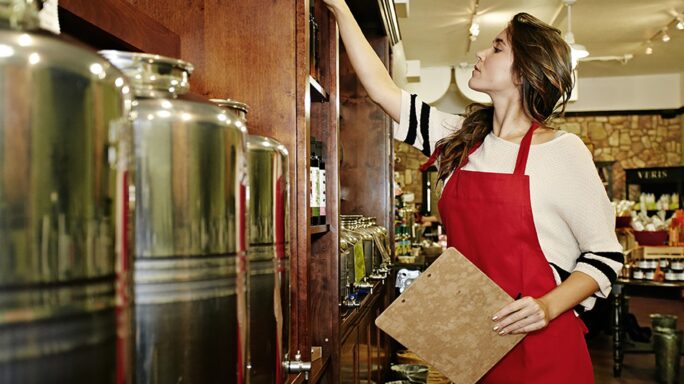How to make a café business plan that works
Create your cafe and coffee shop business plan template here. Learn how to start your business, with specialist advice and resources from Sage.

In the not-so-distant past, independent cafés and coffee shops were rapidly growing alongside popular franchises and chains.
While the pandemic has had a significant impact on the sector, slowing progress and sending plans askew, recent forecasts for hospitality are looking a lot brighter.
With business optimism climbing to its highest level since 2015, entrepreneurs across the UK can finally exhale and start to take measured steps towards brewing their business idea into a tasty reality.
Household spending on eating out remained strong, with those businesses tapping into e-commerce left better prepared to weather the storm.
As the economy recovers, that spend is set to increase as restrictions ease, markets stabilise and more disposable income becomes available.
According to the Accenture/HIS Markit Business Outlook, hospitality has jumped up to the most confident sector following a far less positive outlook towards the end of 2020.
Commuter towns, for example, are likely to see a huge surge in demand as people are able to spend time outdoors, and continue working from home.
Getting started
If you’re dreaming of setting up your own café, a thorough coffee shop business plan is the place to start.
You will need one if you are looking for partners, investors or lenders, and it’ll help you stay on track as you work towards your goals.
A business plan also helps you understand the purpose and nature of your company and competitive environment, plus your:
- Unique selling points (USPs)
- Strengths
- Weaknesses
- Strategic goals
- Milestones.
Jim Winship, director of the Café Life Association, says a business plan is especially important in this sector because many people start cafés and coffee shops without any business experience.
“They have a dream that they can do it better than others but don’t think enough about the business side,” he says.
“This puts you at risk, in terms of the business liabilities, if the dream is unrealistic. So, a business plan is critical to help manage this risk.”
This article will help you create a business plan for your café or coffee shop. Here’s what it covers:
How to write a coffee shop business plan
Updating and adapting your plan
Start building your café business plan
Your one stop shop for starting a business
Thinking about starting a business or already putting your ideas into action? We’ve got the resources, expertise and software to help you achieve your goals.

How to write a coffee shop business plan
There are no set rules about what a business plan should include.
Jen Walker, founder of The Split Screen Coffee Company, says: “It doesn’t need to be overly formal but putting your ideas on paper is always useful and helps bring clarity.
“I have ideas flying around my head constantly and organising them has always served me well.
“As well as helping figure out what makes you special, it can feed into your market research, which is essential before making any big financial leaps.”
Before writing your proposal, search online for business plans of your favourite successful cafés and coffee houses to see how they did it.
Kick things off with your personal story.
Use exciting words to sell your idea and draw the reader into the narrative. Be creative with visuals, branding and design features as well as words, but always back this up with realistic detail.
If you want to secure funding, readers will also expect it to contain the following sections.
Executive summary
This should capture the reader’s attention and cover the key points about your business, like an elevator pitch.
Summarise your overall vision and where you fit into the market: the competition, market opportunity, your USP, and why and how you can build a profitable business.
Include details on the funding you’re looking for and how you plan to use it. If you already have some funding, summarise these details.
Business overview
This section includes more detail on the above, plus a look at how you intend to execute key areas such as marketing, advertising, sales and operations.
It could also include exterior and interior designs, plus your website and other brand collateral.
Summarise the size of the market and sales of comparable products in your area and country. Identify any risks and challenges your company might face and how you plan to address or mitigate these issues.
Consider location, passing traffic, and any local amenities such as offices, universities, or business parks, as these will all play a part in how successful your venture is.
“Your café is a business, so you have to approach it that way,” says Jim. “For example, you need to understand the liabilities – of leases, employees and other standing costs – and whether you can support that risk with the likely sales volume.”
Goals
Summarise your short, medium and long-term goals with performance measures and milestones.
Include daily sales targets and consider how you can increase both volume and revenue by selling extras such as coffee mugs, branded bags of your house roast, or even tote bags.
Say how you will meet these goals and make sure they are SMART: Specific, Measurable, Attainable, Relevant and Time-based.
Track your progress against these goals regularly – and throw in customer or stakeholder feedback while you’re at it.
Audience and market
Your café or coffee shop needs a great location and a clearly defined target market, large enough to support your income needs.
Provide in-depth customer analysis, including your target audience’s needs, preferences and priorities.
Show potential investors why there is a viable market in your target area.
Look at how many work premises are nearby, and how many might need sandwich deliveries, catering services, or provide footfall business.
Count how many people walk past at peak times and get demographic information about the area.
“There may be a good reason for one area having lots of coffee or sandwich shops and there may be room for another,” says Jim.
“But do your homework. Stand on the street and see what people are doing to understand the footfall.
“Where are they going to and from, at lunchtime, if it’s a sandwich shop, or while shopping if it’s a coffee shop in a shopping area. Prove there is sufficient volume to make it viable.
“Also, analyse the competition and whether your shop will be sufficiently different and attractive that people come to you instead.
“You need to do better than competition, which is difficult, or offer something unique.”
Products and services
Include details of menus and any other products you sell, plus some information on where you will source materials and ingredients from, and how you’ll market your products.
Show how you source, price and present your goods to attract your target market.
Post-pandemic, it’s more important than ever to consider how delivery, click and collect, and ecommerce factor into your business.
This has been a lifeline that kept doors open and jobs secure for the majority of cafés and restaurants, and your reader will be looking for this kind of foresight.
People
Mention of all your key people, with skills and experience, and any roles you plan to hire for, whether that’s full or part time.
Explain the management and ownership structure and any plans to evolve it.
Outline how you plan to train, reward, and incentivise your staff; this kind of detail showcases the level of thought and research you’ve put into your business idea.
Financials
Include all your costs, from initial and ongoing to standing and variable. State your projected sales and profits after tax and outgoings.
Jim advises: “Cost every single item in your product to make sure you can price it for profit. People lose sight of that sometimes.
“Only after doing all the sums can you see whether the business will give you the income you need.”
If you’re not sure where to start when it comes to getting accurate financials, check out our guide on estimating figures for your business plan for more detailed information.
And when it comes to staying on top of your financials, using good cloud accounting software aimed at the hospitality industry will put you in good stead.
Updating and adapting your plan
As your business evolves, your strategy and goals will change, so update your plan as often as possible – annually, quarterly, or even monthly.
“The more you stay on top of it, the better you can deal with issues that arise, so I recommend updating your plan monthly,” says Jim.
“If you are a small independent firm, you have the advantage that you can change quickly, but only if you recognise the need to.”
If you want to expand, ask yourself: “Do I understand the very different management skills and stresses involved?”
As well as updating your plan often, Jen recommends tailoring it to your intended reader.
“My plan has taken different forms depending on my audience,” she says. “For example, it has been handwritten, typed, and even used photos like a mood board.
“Think about who you are writing this plan for – your eyes only or potential investors?
“Others may not have the same interest in your concept as you do so make it clear, personal and interesting to them.”
Coronavirus and coffee shops
In the past year, most cafés have changed their business plans drastically because of the trading challenges created by the pandemic.
As coronavirus recedes, you may have to plan your costs even more carefully; you may, for example, have backlogs of rents and loans to repay or renegotiate.
Or you may want more funding to exploit new opportunities.
“Banks are now offering pay-as-you-grow repayment plans, so if you need this, talk to your bank manager,” says Jim.
“We suggest any outstanding rent should be spread over the life of the lease and that rental agreements should be based on a percentage of turnover.”
Jen says she has changed her business plan radically since the start of the pandemic.
“I’m now collaborating with another local small business and we now have a joint plan for growing our range together,” she says.
“Collaborating has been a wonderful experience and has improved cash flow and given me more time off.
“My advice is not to view others as competition but think about how you can come together to improve your offering and boost your local economy.”
As the economy recovers, following your business plan’s structure will help you run a tight ship financially, take advantage of new opportunities, and persuade potential partners or investors to back you.
Start building your café business plan
When writing your plan, take your time, research thoroughly, and ensure all elements are accurate and realistic.
But don’t make it a dry or tedious read. Investors back people as much as businesses, so let your personality and passion shine through.
Use our free business plan template for small food and drink businesses to get started on your café proposal. This includes everything you need to set out for success and show potential investors if and when that time comes.
We also provide a business model canvas that can help you distil the most important parts of your plan into a one-page document – check it out.
Business plan template for food and drink companies
Want to create a business plan for your food or drink company but not sure how to do it? Download our free and easy-to-use business plan template and you can get started.







Ask the author a question or share your advice